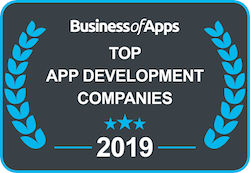Do you have an app idea that you can't wait to turn into a reality? Before launching your creation, it's important to consider the design of its icon – after all, this ishow users will remember and recognise your app amongst the sea of apps available today. An eye-catching and reflective app icon is essential to stand out from the crowd. In this blog post, we’ll provide tips on how to create an app icon for maximum user engagement.

Why an App Icon is Important
One of the most important features when optimising an application for an app store is the icon. The app icon is typically the initial element that catches a user’s attention when searching for apps. Its design could either entice or discourage the audience from clicking on the app page. A clean and distinctive design can help your app stand out amongst competitors. Creating a positive initial impression is crucial for boosting conversion rates, as it can increase them by up to 35%. Approximately 50% of individuals choose to download an app based on a strong first impression, and 60% of visitors will not continue scrolling past it. For reference, the average conversion rate is 26.4%, while the highest is 82% and the lowest is 0.36%, specifically for apps in the games category.
It’s crucial to consider your app’s branding carefully. To help with this, you can ask yourself a few questions about your brand, such as: Who will use your app and for what purpose? What distinguishes your app from the competition? What message do you want to convey to your app users? What is the tone of your app? What emotions do you want your users to experience when utilising your app? By answering these questions, you’ll have a distinct understanding of your brand identity.
The Power of Colour
Selecting the appropriate colour for your app icon is crucial to its success as it reflects your brand’s personality and theme. Colours have a powerful influence on consumers, with 90% of them making judgments about products based solely on their colour. In fact, the visual aspect of a product plays a significant role in the purchasing process, with 92.6% of people considering it the most important factor when buying something. For instance, as an experiment, Heinz changed their ketchup from red to green in 2000, resulting in the sale of 10 million bottles in just seven months, generating$23 million in revenue.
Colours show the feeling and mood your brand represents, and it tells consumers subconsciously how they are supposed to feel when they see your app. Colours are often linked to emotions and personality traits. Colours are often associated with specific meanings. For example, blue is commonly associated with trust and security, brown is often associated with the outdoors, purple is often seen as a symbol of sophistication and red is commonly associated with passion. Colours should accurately represent the values your brand embodies.
Tips on App Icon Colour
It’s essential to maintain consistency in your app’s appearance. This means using a consistent colour scheme throughout, including in your app icon. Users expect the icon to accurately reflect the look and feel of the app when they open it. Therefore, it wouldn’t make sense for the icon to be visually appealing while the app itself appears lacklustre.
Having contrast is important in design. High and low contrasts allow colours to stand out from each other at varying degrees. It’s crucial to ensure that your text or object contrasts well against its background. For example, yellow is a bright colour, while blue is softer and darker, resulting in higher contrast. Lower contrasts that use different tones of the same colour can be challenging to read, so high contrast is usually preferred. However, some high contrasts can be too harsh on the eyes, such as bright green against black. It’s essential to find a balanced colour scheme with just the right amount of contrast to make your app icon aesthetically pleasing.
Have you heard of complementary colours? The idea is that opposites attract, making them a great choice for designing eye-catching icons. Complementary colours are located on opposite sides of the colour wheel, such as red and green, blue and orange, and yellow and purple. Give it a try and see how it works for your design.
When creating content, it’s essential to consider colour blindness. High-contrast designs can make things easier to read and more enjoyable to see for those who are colour-blind. It’s no surprise that blue is a popular choice for icons, as it’s a colour that even those with colour blindness can distinguish.
Tips on Creating an App Icon
When creating an icon for your app, there are a few key factors to keep in mind. First and foremost, it should be simple, recognisable, and unique. You want it to stand out in a crowded sea of apps. Additionally, the design of your icon should reflect your brand identity and make an emotional connection with your target audience. It should convey a clear message about your app’s purpose and be visually appealing enough to entice customers to click and download.
When designing icons, it is crucial to ensure they work in various sizes and shapes. Simply testing on phones and tablets is not enough; icons must also be checked for compatibility with the Apple App Store and Google Play Store. These platforms are typically the first place customers will see the icon. To fit different devices and platforms, icons should ideally come in sizes such as 512pt x 512pt, 256pt x 256pt, 128pt x 128pt, 32pt x 32pt, and 16pt x 16pt. Avoid adding any text to the design, as icons are small and text can be hard to read. It is also unnecessary since the app’s name is already written under the icon.
When choosing an icon for your app, it’s best to avoid using the first letter of your brand, especially if it’s the same as popular apps like Facebook, Pinterest, or Skype. This can cause your app to be overshadowed and confused with others. If you do decide to use this approach, make sure your icon has unique features that set it apart from the competition. Finally, it is important to be original and not rely too heavily on trends or what your competitors are doing when designing your icon.
Contact Us for Web Integration, API and Backend Services in London
Get in touch with our experts here at Red C, who can help you with developing your apps and give you a more comprehensive understanding of iOS. We can also help you with web integration, API, and backend services based in London, which can transform your business processes and your customer experience offering.
Contact us using our contact form or by phoning us.



